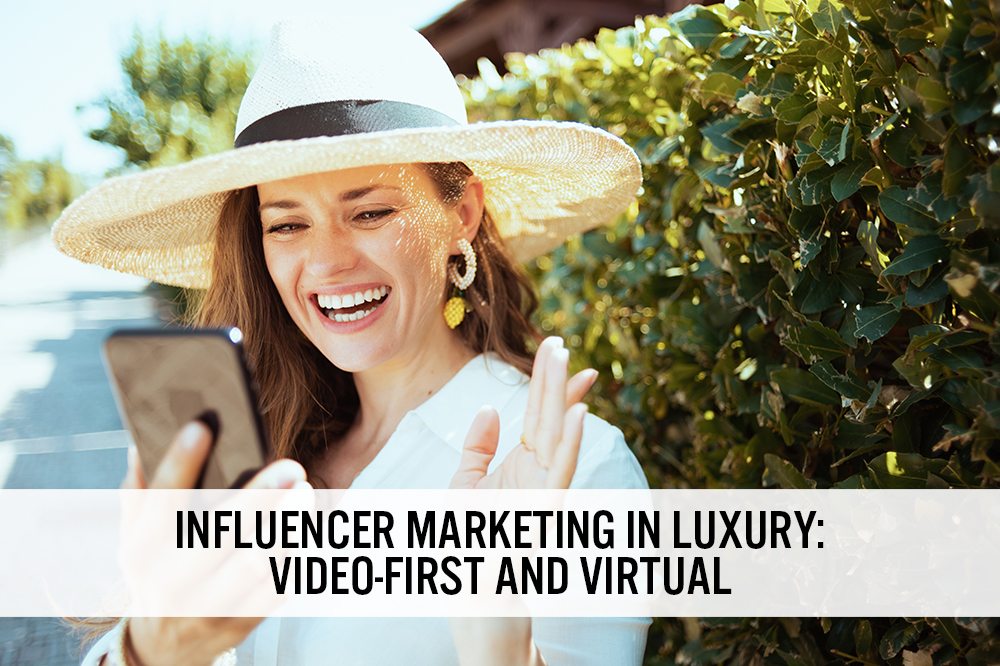
DIpil Das
Introduction
What’s the Story?
Influencers—experts within a sector known for swaying consumers to purchase products or services or spur other actions over social media—are growing increasingly powerful. Traditional marketing campaigns appear to be ceding relevance as social media’s reach and that of influencers becomes increasingly ubiquitous. This is benefitting luxury retail as consumers tend to view influencers as more authentic than traditional advertisements.
We discuss how luxury brands can use influencers to drive sales, what younger consumer audiences seek and the future of luxury influencer marketing.
Why It Matters
Social media is turning into the primary avenue for luxury discovery—especially for younger consumers, and a majority are influenced to purchase after product discovery via social media. This reflects the strong proposition for influencers within luxury brands’ social media space.
Almost 80% of Gen Z consumers and 70% of millennials follow luxury brands on social media, and of those, at least 80% have purchased a product from those brands after discovering it on social media, according to an October 2021 survey of US luxury shoppers by fintech services firm Klarna.
Even among older shoppers, over half of Gen X consumers and two-fifths of Baby Boomers follow luxury brands on social media, of which 64% of Gen X and 48% of Baby Boomers have purchased a product after discovering the brand on social media.
Figure 1. US: Luxury Shoppers That Follow Luxury Brands On Social Media: Proportion That Were Influenced To Purchase After Discovery on Social Media [caption id="attachment_151665" align="aligncenter" width="700"]
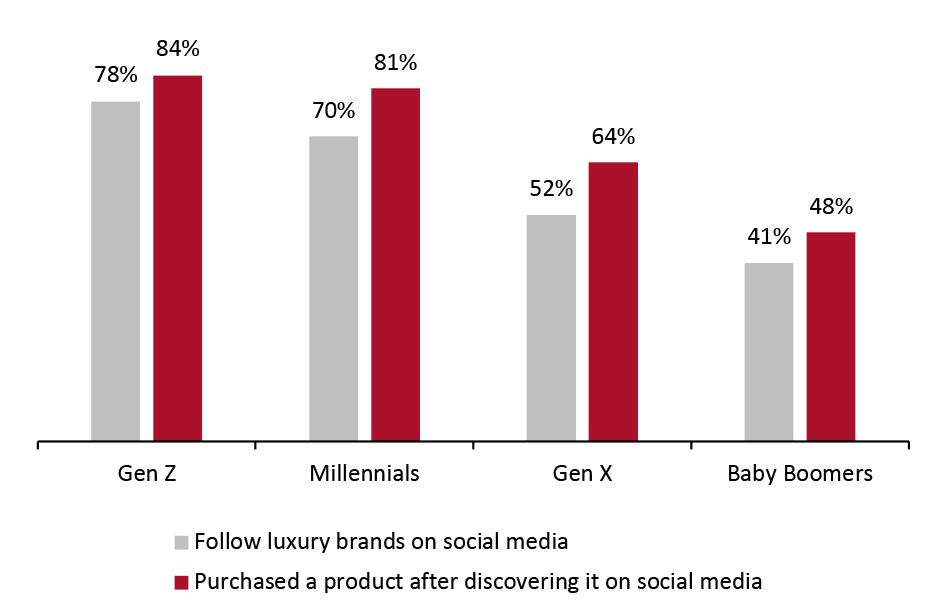 Source: Klarna[/caption]
Source: Klarna[/caption]
The Role of Luxury Influencers: Coresight Research Analysis
Influencers play varied roles, from brand ambassadors to sales advisors to simply being experts on specific subjects that consumers trust. Therefore, it is important that brands choose the right influencers to represent them via suitable platforms for their target audience.
1. Luxury Consumers Seek Insights from Influencers Before They Buy
Consumers look to influencers for information, to keep up to date on new trends and connect with like-minded individuals. Influencers that luxury brands collaborate with must be authentic, knowledgeable and charming to be able to engage with their audience on a meaningful level.
Around 42% of US consumers follow influencers on social media, according to a Coresight Research survey from March 2022. Among these, around 84% reported that they are affected by influencers/celebrities at least sometimes while shopping. While the above is for retail in general, we believe the share among luxury shoppers is similar.
Moreover, Klarna data indicate that a significant number of shoppers are affected by influencers when it comes to online shopping: 50% of Gen Zers and 41% of millennials seek insights from influencers before making a luxury purchase online.
Figure 2. US: Shoppers That Follow Influencers On Social Media: Proportion That Were Influenced to Purchase After Discovery on Social Media [caption id="attachment_151666" align="aligncenter" width="701"]
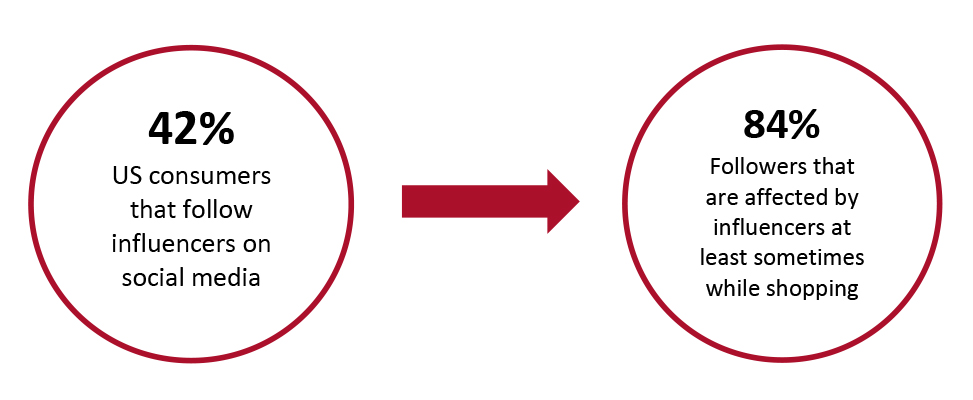 Base: 570 US respondents aged 18+ who use social media as part of the shopping process and follow influencers/celebrities, surveyed in March 2022
Base: 570 US respondents aged 18+ who use social media as part of the shopping process and follow influencers/celebrities, surveyed in March 2022 Source: Coresight Research [/caption]
Influencers have established a key role in online shopping decisions among consumers in China in particular. For example, Tao Liang is a key opinion leader (KOL) or influencer known as Mr. Bags on Chinese social media platforms with a following of over 10 million as of July 2022.
Liang has worked with several luxury brands, ranging from design consultation to hosting sales promotions on his accounts. He told South China Morning Post that works with brands that his followers “naturally love” and aims to deliver videos that are informative as well as entertaining, making him endearing to his followers.
For example, when recommending Valentine’s Day gifts last year, he humorously highlighted the lightweight quality of a Louis Vuitton bag by measuring it against the weight of an apple, as shown in the image below.
[caption id="attachment_151667" align="aligncenter" width="700"]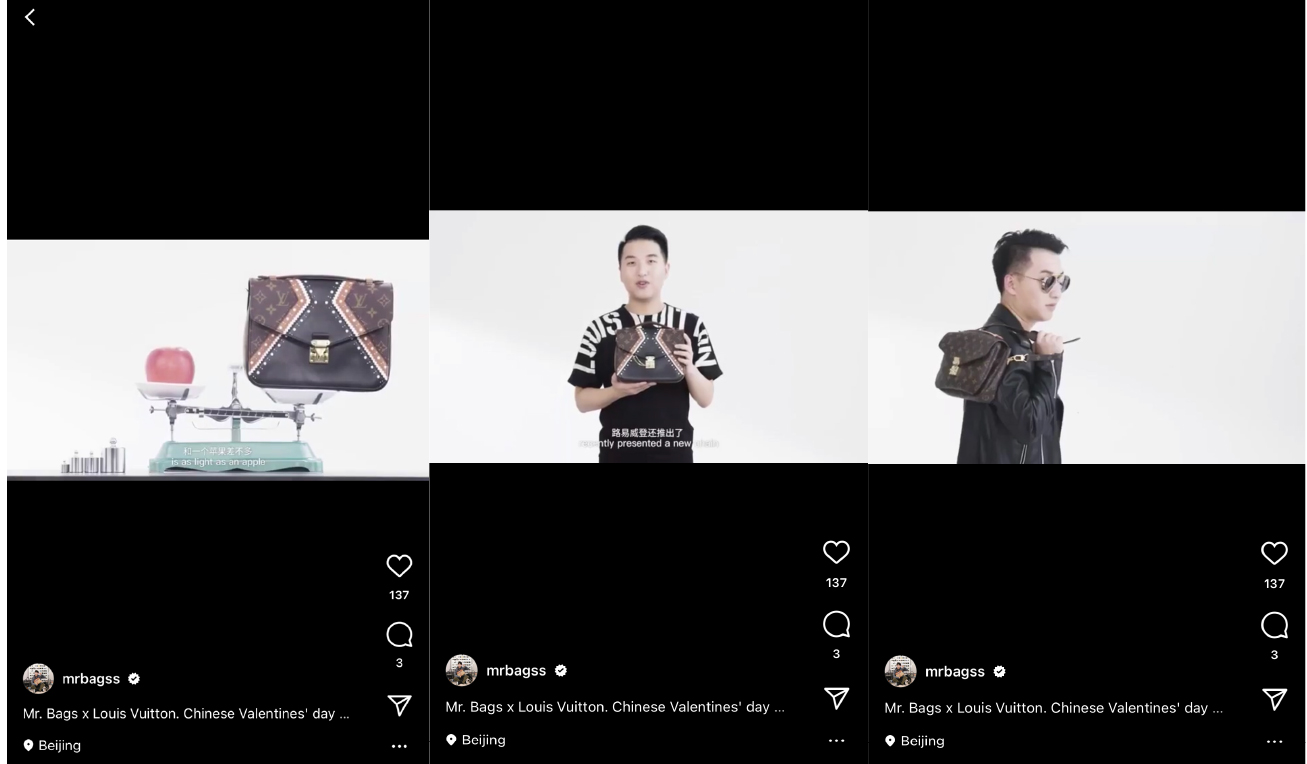 Tao Liang presenting a Louis Vuitton bag on his Instagram as a gift for China’s Valentine’s Day on August 4
Tao Liang presenting a Louis Vuitton bag on his Instagram as a gift for China’s Valentine’s Day on August 4 Source: Mr. Bags [/caption] 2. Celebrities Are the Primary Type of Influencer Consumers Follow Celebrities rank highly among the type of influencers that US consumers follow, with experts such as doctors and professors also well trusted by consumers on social media, Coresight Research identified in a March 2022 survey. Friends or family ranked highly after celebrities, indicating that consumers appreciate genuine and authentic information from people they are close to or those that they trust to be a source of truth. Beauty and fashion influencers are also popular, indicating that these should be key product categories for luxury brands to tap into for influencer-led marketing activities.
Figure 3. US: Respondents Who Use Social Media as Part of the Shopping Process and Follow Influencers/Celebrities: What Kind of Influencers/Celebrities/Creators They Follow (% of Respondents) [caption id="attachment_151668" align="aligncenter" width="700"]
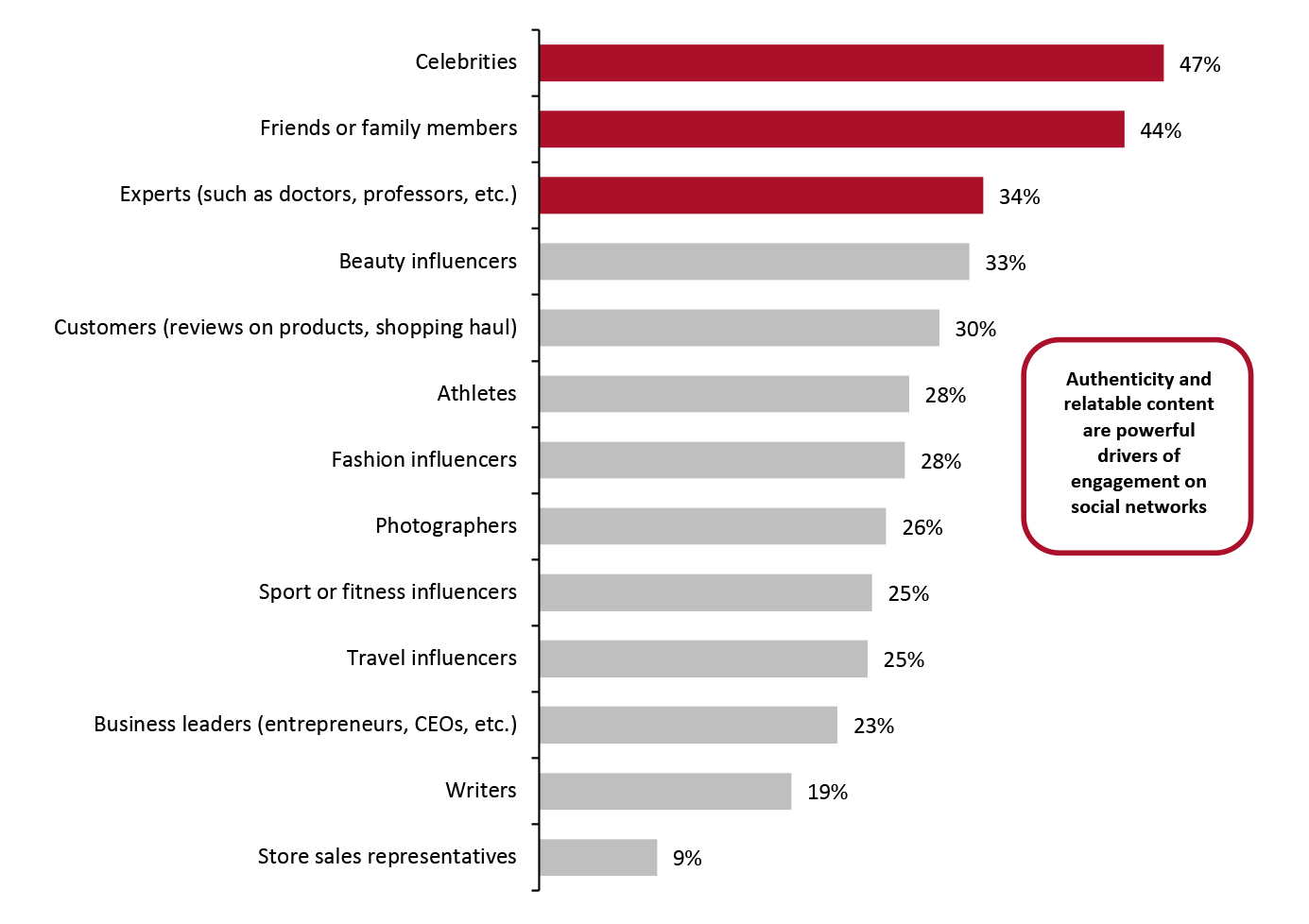 Base: 570 US respondents aged 18+ who use social media as part of the shopping process and follow influencers/celebrities, surveyed in March 2022
Base: 570 US respondents aged 18+ who use social media as part of the shopping process and follow influencers/celebrities, surveyed in March 2022 Source: Coresight Research [/caption]
While consumers value authenticity and expert knowledge, many are seeking entertainment from the accounts they follow—some 60% of US consumers stated this as the main reason they follow celebrities and influencers on social media.
- To read more Coresight Research analysis of our proprietary data on the influence of social media on US consumers, click here.
Figure 4. US: Top Reasons To Follow Influencers/Celebrities [caption id="attachment_151669" align="aligncenter" width="700"]
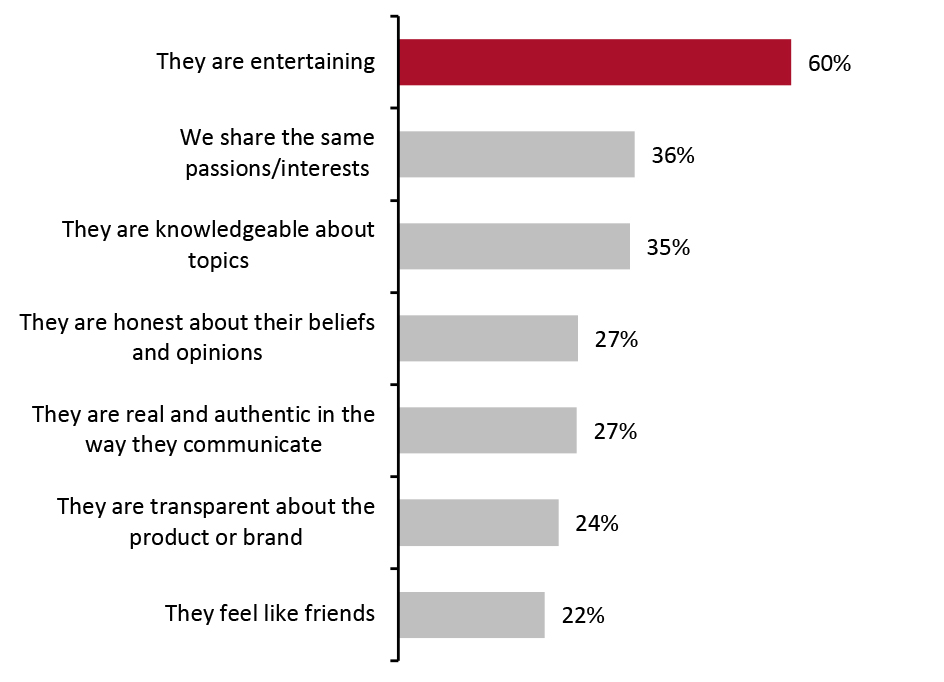 Base: 570 US respondents aged 18+ who use social media as part of the shopping process and follow influencers/celebrities, surveyed in March 2022
Base: 570 US respondents aged 18+ who use social media as part of the shopping process and follow influencers/celebrities, surveyed in March 2022 Source: Coresight Research [/caption]
Several luxury brands have partnered with famous actors, musicians and other celebrities as brand ambassadors. In April 2021, Louis Vuitton announced South Korean boy band BTS as its global brand ambassador. The band of seven musicians has a massive global fan following and Louis Vuitton clothing or accessories worn by members at public appearances typically sell out shortly after, reflecting the tremendous power they can exercise over brand sales. For example, the white printed Louis Vuitton T-shirt worn by BTS band member Jimin sold out worldwide following his 2021 interview with the late Virgil Abloh, Director of menswear at Louis Vuitton.
[caption id="attachment_151670" align="aligncenter" width="438"]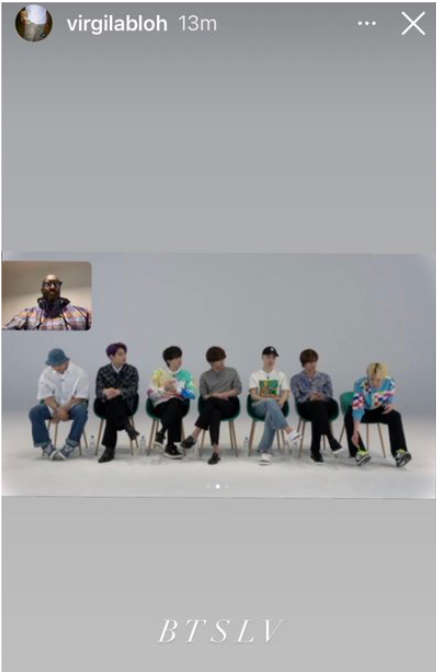 Jimin (third from right) sporting a Louis Vuitton t-shirt in an interview with the late Virgil Abloh. Screenshot from Abloh’s Instagram story
Jimin (third from right) sporting a Louis Vuitton t-shirt in an interview with the late Virgil Abloh. Screenshot from Abloh’s Instagram story Source: Len7 SLOW’s Twitter Post [/caption]
Burberry has focused on the demand for entertainment in its influencer partnership with a social media account called “Sylvaniandrama,” which creates short entertaining videos using animal figurines from the Sylvanian Families doll collection. To showcase Burberry products, one video features a character carrying a mini version of the Burberry Lola bag. Another character complements the bag, to which the bag carrier responds, “Thanks, it’s a Lola.”
[caption id="attachment_151671" align="aligncenter" width="700"]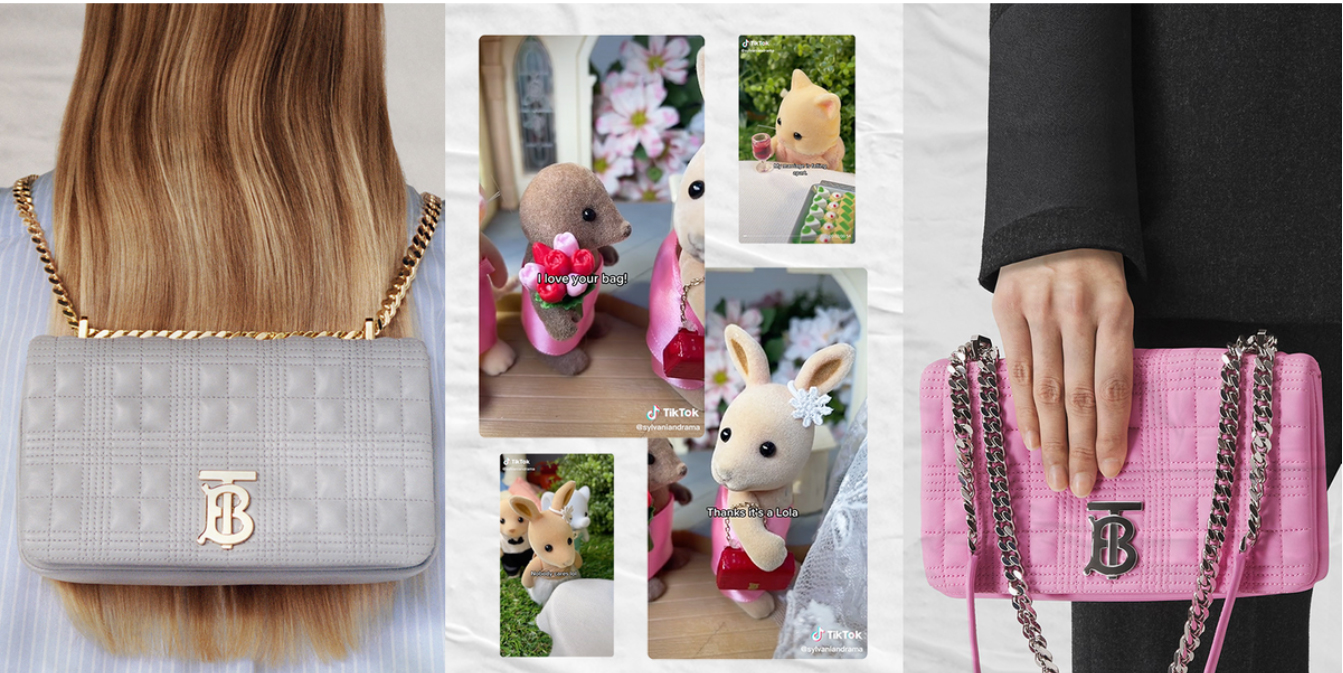 Burberry showcasing its Lola bag in partnership with popular social media account Sylvaniandrama
Burberry showcasing its Lola bag in partnership with popular social media account Sylvaniandrama Source: Vervetimes [/caption]
Luxury brands must seek out celebrities that have a prolonged recall value, such as BTS, or timeless icons, such as Sylvanian Families dolls, to extend the period of influence on their consumers. While celebrities or influencers with sporadic moments of fame may drive sales momentarily, they typically fail to build a long-lasting impression on the consumer or drive anything other than temporary popularity for the brand.
3. “Genuinfluencers” Appear Integral To Pursuing Sustainability Goals
“Genuinfluncers” do not promote or sell products but rather share their experience, expertise and passions on specific subjects. If brands and retailers overuse conventional influencers to plug or sell products, there is a risk of appearing disingenuous and sparking “influencer fatigue” among consumers. “Genuinfluencers” offer an alternative engagement method and are an important influencer segment for luxury brands, particularly as they pursue concerns where credibility is key, such as sustainability.
While the average number of posts per week by influencers on Instagram increased from 0.56 to 4.47 from 2019 to 2021, engagement rates fell from 1.67% to 1.18%, according to data from social media data firm Rival IQ. This indicates that consumers’ inclination to engage with posts declines as posts proliferate.
Figure 5. Average Posts Per Week Versus Engagement Rates of Influencers on Instagram [caption id="attachment_151672" align="aligncenter" width="699"]
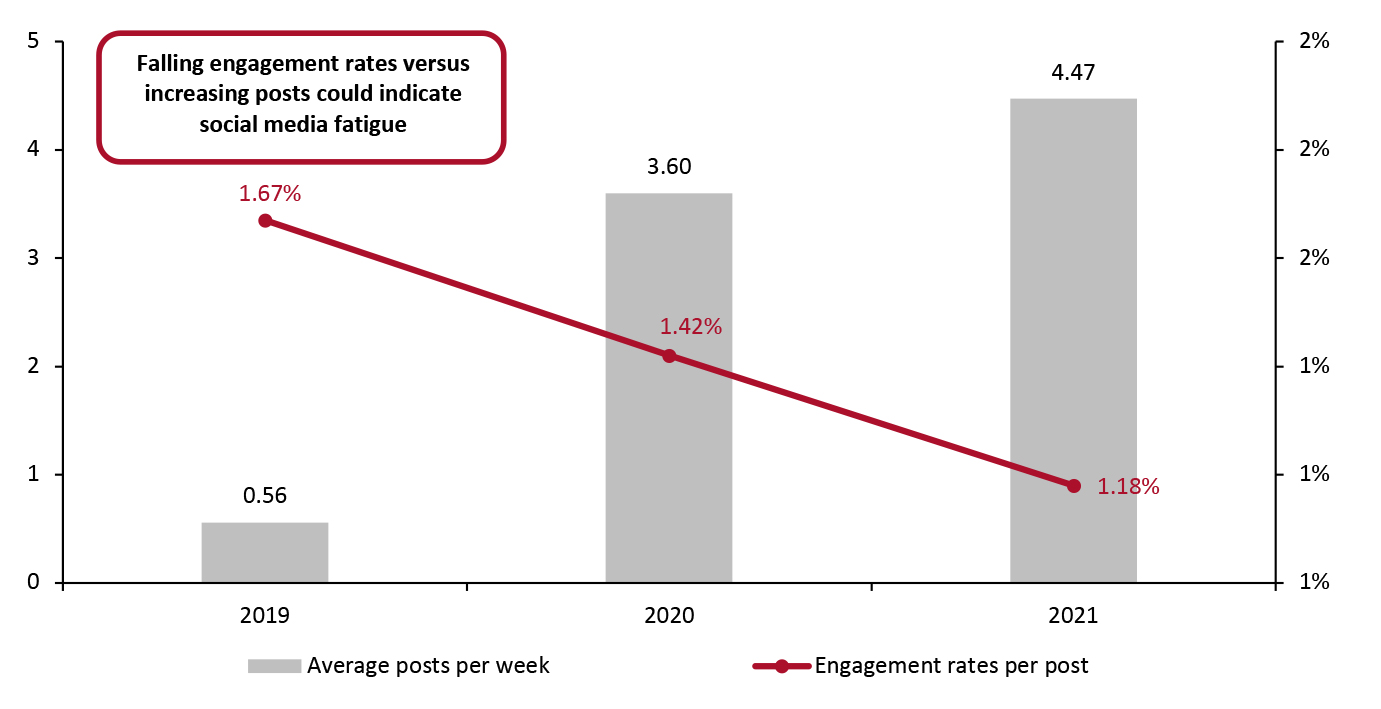 Source: Rival IQ[/caption]
Source: Rival IQ[/caption]
Luxury brands must be prudent in posting with the best frequency for their follower base. Engaging influencers that simply have a message for the audience and are not known for pushing products could make consumers view the brand positively.
For example, Gucci partnered with retired fisherman Gerald Stratford for a video shoot featuring its Off the Grid 2021 collection, which has a focus on sustainability. According to the brand, Stratford was a suitable choice as he already shared videos about gardening and growing vegetables at home on social media. In the video, which was made in partnership with media company Highsnobiety, Stratford is seen gardening and tending to vegetables while a pair of visitors decked out in Gucci clothing visit him. The video and collaboration led to numerous positive news reports and reactions globally.
4. Virtual Influencers May Be the Future of the Influencer Industry
As the metaverse pervades further into mainstream retail, virtual influencers or meta humans will increasingly become the norm. As immersive technology develops further, meta humans are becoming more realistic and almost indistinguishable from humans on social media and virtual world platforms.
Signing up celebrity brand ambassadors involves a significant marketing budget, several legal implications and risks, including reputational risks to the brand—if the celebrity is entangled in a controversy, it reflects poorly on the brand and can impact sales. To avoid these concerns, brands and retailers are developing virtual idols and using them for highly targeted and personalized marketing campaigns.
Several digital games and decentralized social applications already use virtual humans for their storylines and to interact with users, which are fast becoming influential among digitally savvy younger consumers. As meta humans are controlled entirely by their developers, brands and retailers can tailor the idols to specific audiences and consumer bases, which is naturally impossible with an actual human ambassador.
For example, in May 2021, China’s first virtual human influencer, Ayayi, debuted on Chinese e-commerce platform Xiaohongshu. Since its launch, Ayayi has collaborated with several brands, including Tiffany & Co. on its Knot jewelry collection in February 2022, Louis Vuitton for its Fall Winter 2021 men’s collection, beauty brand Guerlain in June 2021 and L’Oréal in March 2022.
[caption id="attachment_151673" align="aligncenter" width="700"] Ayayi’s collaborations with Tiffany & Co. (top left), Louis Vuitton (top right), Guerlain (bottom left) and L’Oréal (bottom right)
Ayayi’s collaborations with Tiffany & Co. (top left), Louis Vuitton (top right), Guerlain (bottom left) and L’Oréal (bottom right) Source: Ayayi’s Instagram [/caption]
5. Video Content and Powerful Visuals Are Important Drivers of Luxury Sales
Alongside enlisting influencers, luxury brands and retailers should look to developing compelling visual content to disseminate their story to consumers.
Video content features strongly among the top online content driving online luxury sales, proving notably popular among younger consumers. Millennials and consumers in older generations prefer strong visuals, while live chats with product experts or sales associates are the least popular content type among all age categories.
Figure 6. US: Top Online Content Driving Online Luxury Sales [caption id="attachment_151674" align="aligncenter" width="699"]
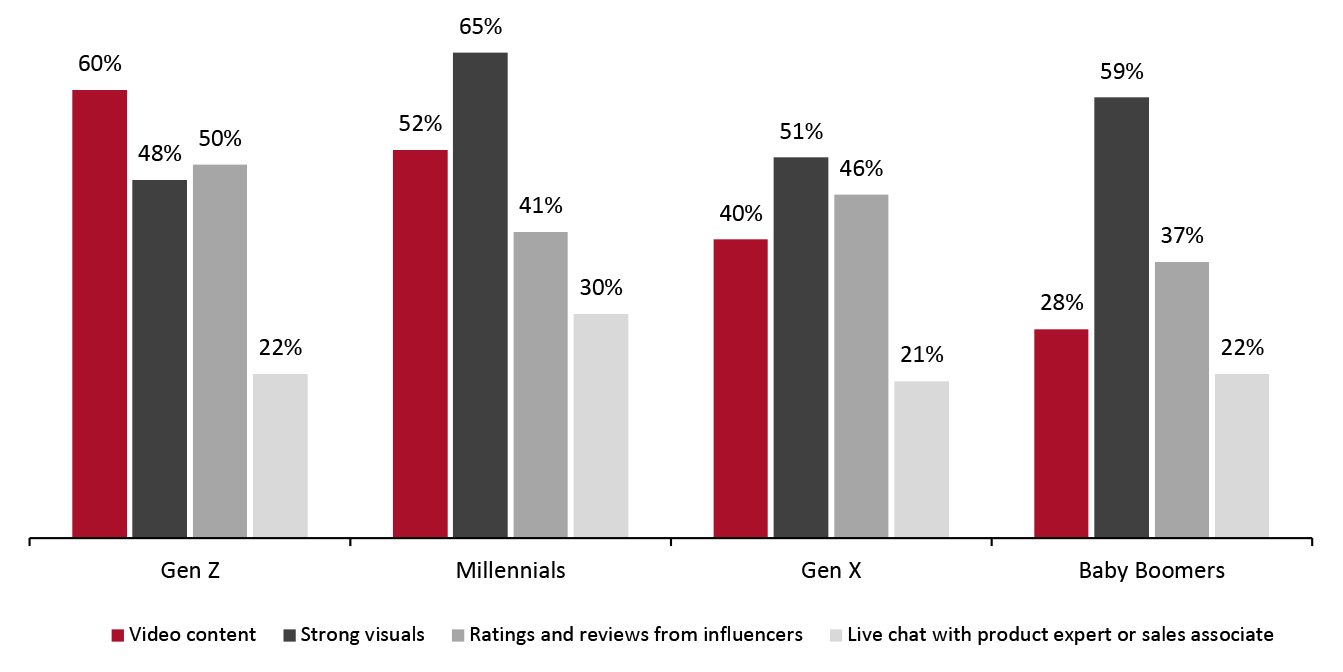 Source: Klarna[/caption]
Source: Klarna[/caption]
Gucci has produced several creative films. The company’s most recent film, Aria, commemorates 100 years of the brand’s existence. The film opens in an imaginary club as an ode to London’s Savoy Club where founder Guccio Gucci once worked. Models showcase various items of clothing and accessories in the Aria collection, many of which are homages to Gucci’s equestrian roots and its iconic pieces from over the years. The movie included pieces from the house’s hacker project—a mashup between Gucci and Balenciaga, juxtaposing the past with the present. The film ends with the models leaving the club and entering a dreamy forest-like landscape as the audio plays “what the future holds,” making the viewers feel as though they have journeyed with Gucci through the century.
[caption id="attachment_151675" align="aligncenter" width="700"]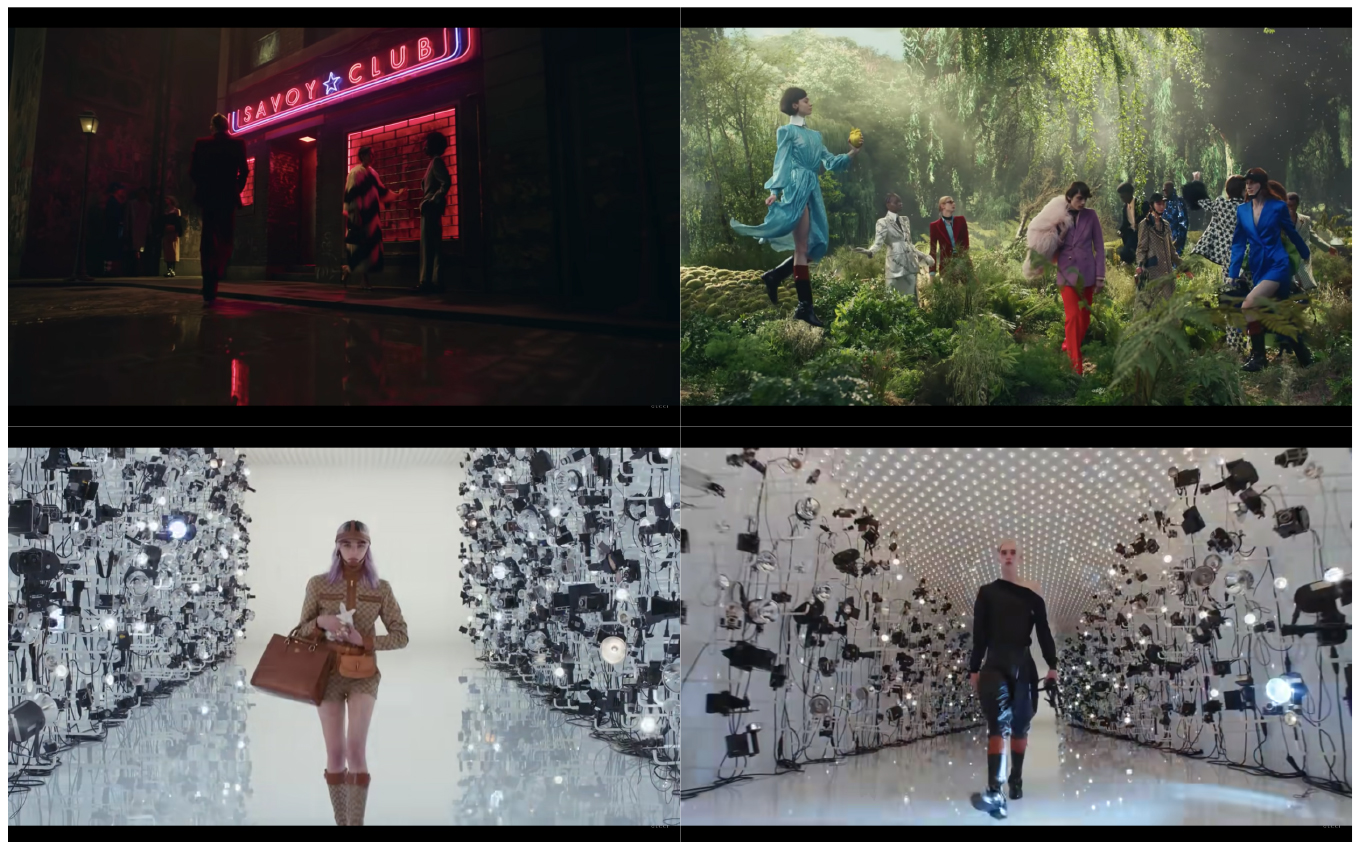 Scenes from Gucci’s Aria film: the opening and closing settings (top left and right) and models showcasing clothing and accessories from the collection (bottom)
Scenes from Gucci’s Aria film: the opening and closing settings (top left and right) and models showcasing clothing and accessories from the collection (bottom) Source: Gucci [/caption]
6. Luxury Brands Should Utilize Video-Led Platforms To Tap Younger Shoppers
Video-driven platforms allow influencers and brands to demonstrate products effectively and in an entertaining manner, and are especially popular among younger shoppers.
Instagram, TikTok and YouTube are highly popular among younger audiences while older generations tend to use Facebook as their primary platform for shopping. Instagram is the dominant platform among the 18–29 age group, used by 53% of social media shoppers, according to a Coresight Research survey from March 2022.
Figure 7. US: Top Five Social Media Platforms for Shopping, By Age [caption id="attachment_151676" align="aligncenter" width="701"]
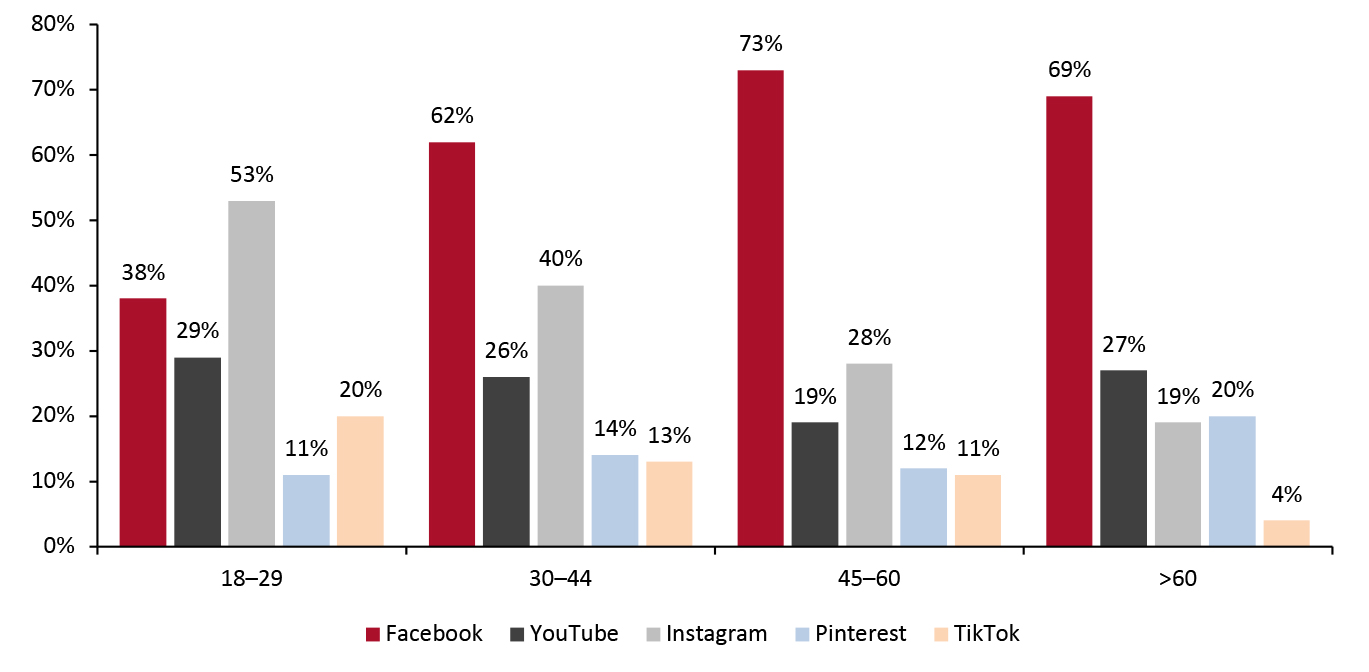 899 US respondents aged 18+ who use social media as part of the shopping process surveyed in March 2022.
899 US respondents aged 18+ who use social media as part of the shopping process surveyed in March 2022. Source: Coresight Research [/caption]
Video content was the most engaging post format on Instagram in 2021, according to the company, garnering an average of 24 comments and 1,098 likes globally, per post. This compares to an average of 15 comments per image post, according to the 2022 Instagram Engagement Report by social media monitoring companies HubSpot and Mention. TikTok is a video-only platform, and is often attributed with driving preferences for video among younger consumers.
Luxury brands that work with influencers on short-form video or video-based sales strategies such as livestreaming stand to benefit from the ongoing shift to video and attract young audiences. Hugo Boss partnered with Khaby Lame in January 2022—Lame began making humorous TikTok videos in early 2020 after losing his job at a factory in Italy. He accumulated more than 200,000 followers within the next 12 months, and as of July 15, 2022, he has 147 million followers on TikTok and 79 million followers on Instagram.
On April 13, 2022, Lame posted a funny video on Instagram of a person unnecessarily complicating a workout and wore a Hugo Boss T-shirt while demonstrating the easy, common-sense solution to it in his trademark style. The post has over 4.4 million likes and about 45,000 comments. The partnership will boost the appeal of Hugo Boss among a younger consumer segment that wants to be entertained but also values authenticity and simplicity—the key themes of Lame’s videos.
[caption id="attachment_151677" align="aligncenter" width="700"]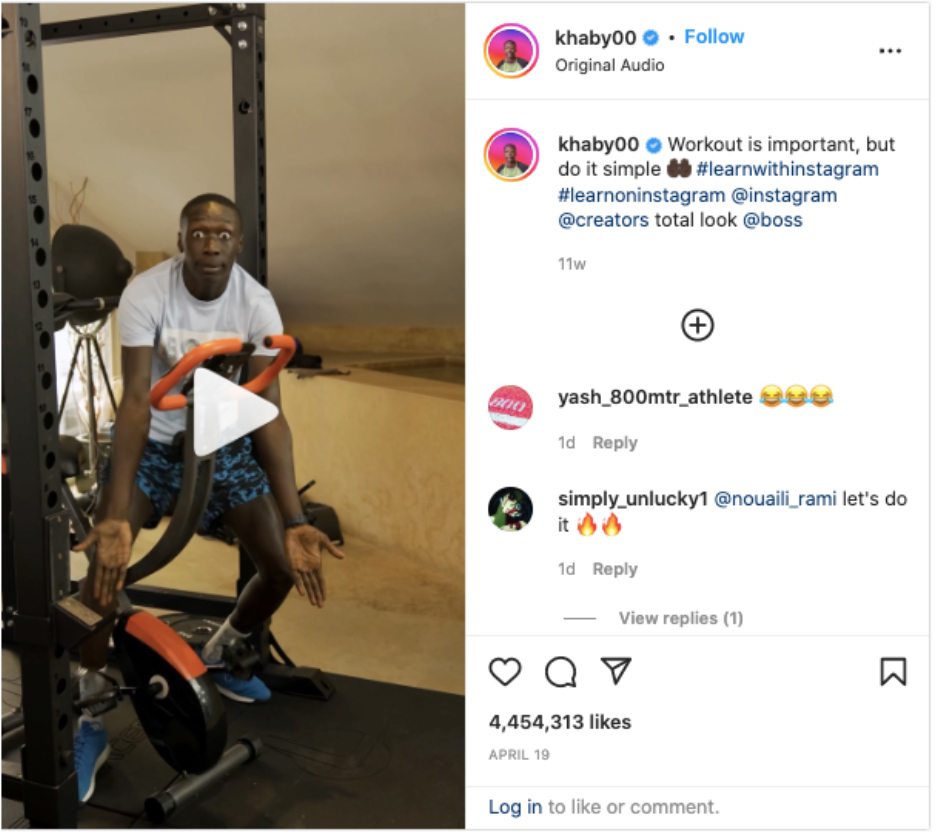 Khaby Lame wearing a Hugo Boss T-shirt in his Instagram post about keeping workouts simple
Khaby Lame wearing a Hugo Boss T-shirt in his Instagram post about keeping workouts simple Source: Instagram [/caption] Luxury brands must also learn how to adapt quickly to social trends to capture young consumer audiences effectively. The #GucciModelChallenge, for example, was started by TikTok user Morgan Presley in August 2020, which was designed to prompt consumers to dress in items from their wardrobe that could replicate the style of Gucci fashion models. Presley advises in her video that users could pull off Gucci-inspired looks by layering items of clothing such as “a random colorful turtleneck, a shirt that does not match the turtleneck, a vest, a headscarf” and other items. Gucci took the humorous parody of its high fashion in its stride, announcing a new video project featuring a number of social media users that presented their looks as part of the challenge. [caption id="attachment_151678" align="aligncenter" width="700"]
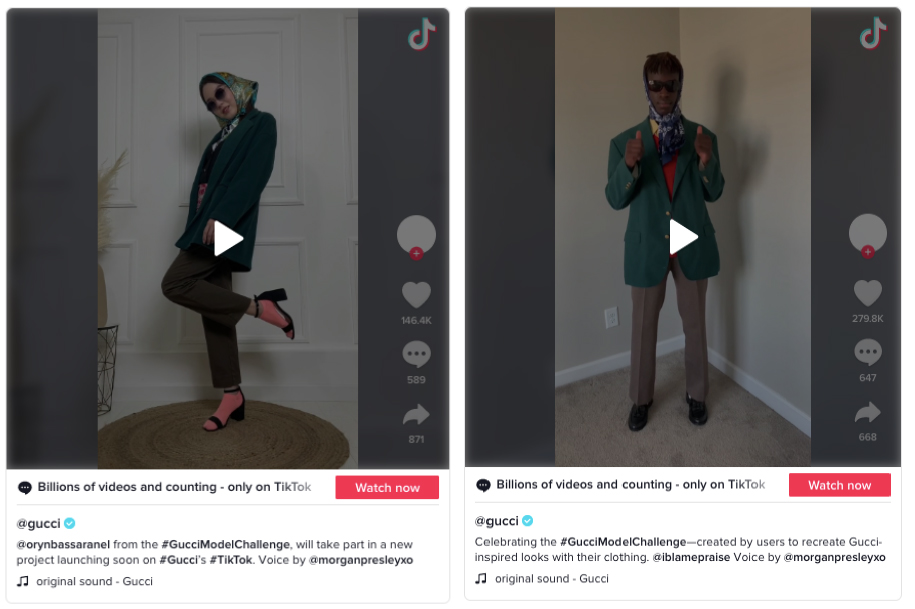 Gucci reposting selected looks from the #GucciModelChallenge to its own TikTok account
Gucci reposting selected looks from the #GucciModelChallenge to its own TikTok account Source: WMagazine/TikTok [/caption]
Retail Innovators
Bambuser is a live video shopping technology provider that helps luxury fashion and beauty brands create one-to-one and one-to-many live shopping events with influencers or sales associates. The livestream shopping events are hosted on the brands’ own websites, allowing them to maintain ownership of the look and feel of the events as well as the shopping process, checkout and customer data.
Bambuser won the 2021 LVMH Innovation Award, benefitting from personalized support through the latter’s accelerator program La Maison des Startups. In February 2022, the startup entered into an agreement with LVMH to integrate one-to-one live shopping solutions into its retail digital offerings to enable its personal shopping, customer service, post-sales or consultation agents to engage in two-way video calls with customers. This agreement comes six months after it signed a similar agreement for a one-to-many solution in August 2021. In June 2022, Bambuser signed an agreement with the luxury conglomerate renewing and extending both agreements for three years.
Bambuser’s clients also include Farfetch, Tommy Hilfiger and Clarins among other luxury companies.
Powerfront Live is a suite of omnichannel live communication applications. It provides messaging, live chat, one-to-one video and one-to-many video among other offerings. The platform can handle and integrate several conversations across multiple platforms concurrently and the dashboard allows sales advisors to toggle between several conversations at once.
Powerfront Live has deployed its applications among several luxury brands, including Bottega Veneta, Gucci, Salvatore Ferragmo and Saint Laurent.
What We Think
We are seeing consumers increasingly looking to influencers on social media for luxury product discovery and information. Luxury brands and retailers must develop their influencer marketing strategies, keeping younger consumers front of mind.
We expect the future of luxury influencer marketing to increasingly be led by virtual idols or meta humans as we advance into the metaverse.
Implications for Brands/Retailers
- Luxury brands and retailers must enlist influencers whose values resonate with their own to be able to develop genuine, authentic story-telling in the videos—a medium that consumers find most engaging.
- As luxury brands and retailers develop their technological infrastructure further, they must include platforms and architecture through which they can create engaging influencer-led digital content and push it to their social channels seamlessly.
- Luxury brands and retailers must be quick to adapt to trends and experiment with new developments, such as virtual influencers, to reach wider audiences and younger consumer bases.
Implications for Technology Vendors
- As short-form videos and virtual influencers increasingly become mainstream in luxury influencer marketing, technology companies should aim to develop applications tailored to provide the sophistication that luxury brands seek.
- Luxury brands are increasingly entering the metaverse and technology companies that can develop meta humans for luxury influencer marketing stand to gain early advantages.